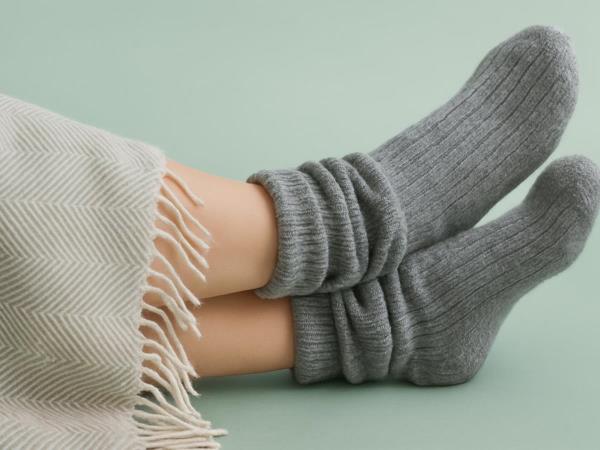In a Korean study (a sleep experiment), people who wore special bed socks at night in a cooler room fell asleep an average of 7.5 minutes faster, slept 32 minutes longer, and woke up less frequently during the night.
Similar studies have been repeated in other parts of the world, and the results have been consistent everywhere. This is no longer a coincidence; these are statistically significant data.
How Socks Affect Sleep Quality
It's not just about falling asleep easier. Socks also contribute to better, deeper, and less disturbed sleep.
In the mentioned Korean study, sock wearers experienced fewer sleep interruptions and awakenings. On average, 7.5 times less than those who did not wear socks. Their sleep efficiency was on average 7.6% higher. Additionally, their feet were on average 1.3 degrees Celsius warmer than those without socks.
This shows that maintaining a stable temperature in the feet during the night is crucial. If the feet are too cold, the body reacts by waking up to restore heat, which disrupts sleep.
When Socks May Not Be Suitable
Of course, not every method is suitable for everyone. If you have circulation problems, swollen feet, diabetes, or similar conditions, socks, especially tight ones, may not be the best choice. Doctors warn that overly tight socks can restrict blood flow. If you feel tingling, numbness, or discomfort, remove them immediately.
Alternatives to Socks if They Don't Suit You
Don't want to wear socks? No problem. There are other clever and inexpensive ways to keep your feet warm before sleep or during it:
- Warm foot bath 30 minutes before bed - this warms up the feet and triggers vasodilation.
- Heating pad or warmer under the blanket at your feet - gently warms the feet and keeps them warm.
- Extra blanket at the foot of the bed - a light addition over the feet, not over the entire body.
These approaches have a similar effect to socks but are more adaptable.
Best Socks for Sleep?
If you decide to make socks a part of your sleep routine, here's what to look out for:
- Materials: choose natural, breathable, and antibacterial fabrics, like cotton, bamboo, or cashmere. These fabrics breathe better and sweat less than synthetic and plastic materials.
- Fit: avoid socks that are too tight. Overly tight socks can compress blood vessels and hinder circulation.
- Thickness: moderately to thicker socks are beneficial as they retain heat better. Adjust the thickness according to the room temperature where you sleep. Thicker socks can be worn in colder rooms.
- Looseness, night fit: some bed socks have a more relaxed fit to avoid excessive pressure.
In 2025, an article in The Washington Post highlighted renewed interest, including viral TikTok trends, where people are wearing socks in bed, as this is gaining attention again. Researchers explain that while it may seem surprising, the theory of vasodilation and internal temperature reduction is well researched.
Recently, public health portals have also mentioned that this is a simple trick with no side effects (if the socks are suitable), and you can try it without worries for as long as you want.
Another study from 2023 showed that heating the feet to around 40-42 degrees Celsius for 10 to 40 minutes before sleep improved subjective sleep quality in older adults.
Clinical guidelines (by the sleep foundation) also acknowledge that socks (or foot warming devices) can help the body cool its interior more easily.
How to Incorporate This into Your Sleep Routine
We suggest a plan that you should try and adjust to work best for you:
- Prepare your socks the night before bed, starting with the thickest ones.
- Wash your feet in warm water or warm them with a heating pad about 20 to 30 minutes before bedtime.
- Put on the socks when you go to bed and leave them on overnight.
- If the socks bother you (feeling too tight), you can remove them during the night.
Also - Sleep Environment: set the room temperature to be comfortable, not too hot, ideally between 15 and 20 degrees Celsius (as if it's too cold, your body sends signals to warm up your feet).
Try this routine for at least 5 to 7 consecutive nights to see if you notice any effects.
If during this time you find that you fall asleep earlier, wake up less during the night, or feel more rested upon waking, it's a sign that the method is working.
Is It Worth Trying?
We are confident that it is definitely worth trying. Socks in bed are a cheap, painless, easy, and non-invasive method that can make a noticeable difference in sleep quality. Of course, there is no guarantee that it will work for everyone and always, especially if you have circulation health issues. In such cases, it's good to discuss this with a doctor or a sleep expert.









 Would you like to be informed about news on the website?
Would you like to be informed about news on the website?

